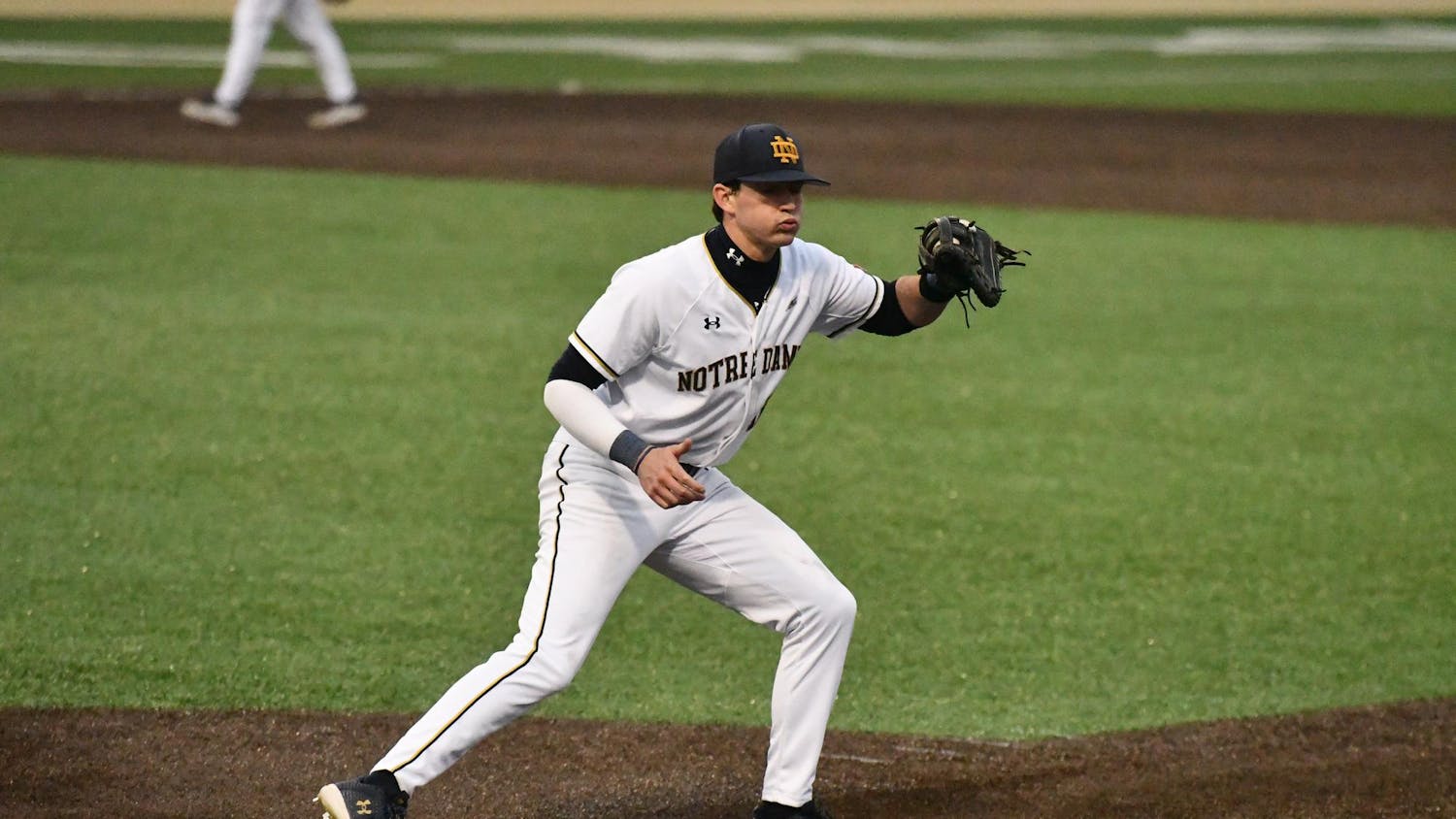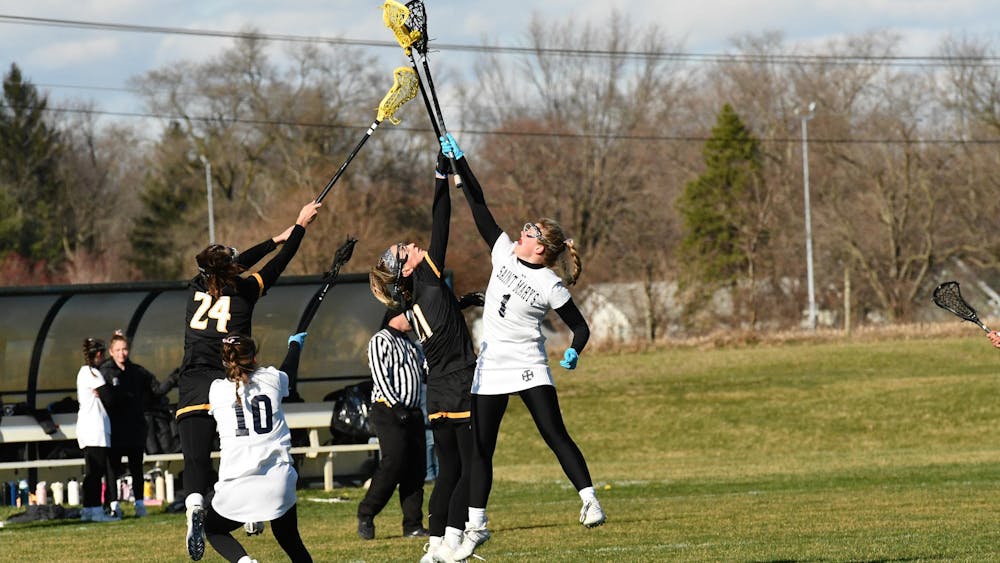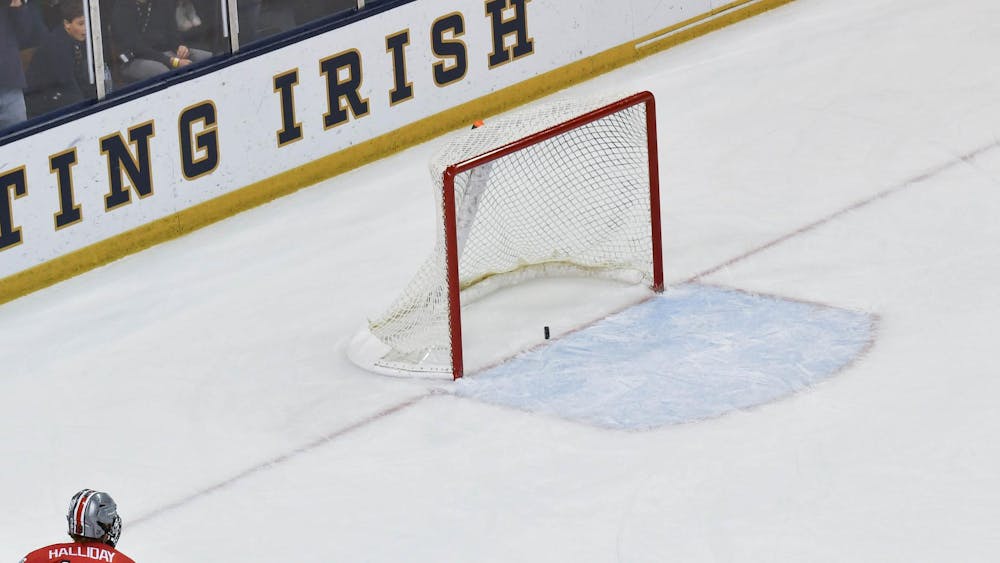Regardless of whether you've attended Notre Dame football games since birth, or like me, hadn’t been to one before freshman year, you’ll soon find that Notre Dame game weekends are a crazy, overwhelming whirlwind of activities. There’s plenty of places to be, people to see and oh yeah, there’s a little sporting event at the end of it all. Notre Dame game weekends are special even beyond the typical college football scene because of the many extra events that celebrate the University’s unique tradition. With so much to do, how can you get the most out of your football weekend? Well, I’m here to give you a quick introduction to several events and traditions you shouldn’t miss. And if you can’t do it all? Don't worry, as sometimes the most rewarding part of the weekend is soaking in the atmosphere that comes from tens of thousands of people being on campus.
Game Day/Weekend Traditions
March Out — The Band of the Fighting Irish holds two separate march outs from the Main Building. At about 4:20 p.m. Friday, approximately 380 band members, some in costumes, march from the Main Building to the parking lots south of Notre Dame Stadium, where they practice for their pep rally performance. The band then does another march out in full uniform on game days at 2:45 p.m. (6:40 p.m. for 7:30 p.m. games), and thousands of fans line up to see the band as it walks to Notre Dame Stadium. On the band’s way to the Stadium, it passes through the Eck Hall of Law, which according to Notre Dame’s tour guides, was built with an arch because of an Indiana law proclaiming that no obstacle can impede the path of the Notre Dame band.
Marching Band Concert — On game days at 2 p.m. (6 p.m. for 7:30 p.m. games), the Band of the Fighting Irish lines up on the steps of Bond Hall, home to Notre Dame’s architecture programs, to perform a 15-minute concert. The concert features traditional Notre Dame songs, such as “Hike, Notre Dame” and “Damsha Bua,”as well as selections from that game’s halftime show.
Pre-game Band Performance — Approximately 30 minutes before game time, the Band of the Fighting Irish takes the field. After performing some traditional Notre Dame tunes, the band leads the crowd in the renditions of “America the Beautiful”and “The Star-Spangled Banner.”The band concludes its performance by playing the“Notre Dame Victory March” and forming a tunnel through which the Irish football team enters.
Banners — Several of Notre Dame’s 30 residence halls have some sort of game day tradition, but two of the most visible traditions can be found at Carroll Hall and Zahm Hall. The men of Carroll Hall, which is located on the banks of Saint Mary’s Lake, raise a 90-foot tall banner made out of bed sheets that reads, “Go Irish.” The residents of Zahm, which is situated on the University’s North Quad, similarly raise a 90-foot tall banner, which reads, “Here Come the Irish.” End of Third Quarter — The Band of the Fighting Irish plays Tchaikovsky’s 1812 Overture at the conclusion of the third quarter. Students nod along to the song while also honoring the current head coach by making a gesture with their fingers (forming an “L” for Lou Holtz, a “K” for Brian Kelly). After the band finishes, retired Indiana state police officer Sgt. Tim McCarthy reminds fans to drive home safely. His doesn’t just make a mundane announcement, however — McCarthy manages to interject a clever pun into all of his warnings, much to the crowd’s delight.
Alma Mater — At the end of every game, Notre Dame football players make their way to the northwest corner of Notre Dame Stadium, where they raise their helmets in a salute to the Notre Dame student section. The players and students alike then sway arm-in-arm to “Notre Dame, Our Mother,” the University’s Alma Mater.
Running through Stonehenge — After major victories, Notre Dame students run through the Clarke Memorial Fountain, also known as “Stonehenge.” After years of underuse, “Stonehenge” saw plenty of action during the 2012 season — students ran through the fountain after Notre Dame’s wins over Michigan, Oklahoma and Wake Forest.
On-Campus Sites
The Main Building (Golden Dome) — The most iconic landmark at Notre Dame, the Main Building mainly houses administrative offices, including the office of Fr. John Jenkins, the University’s president. Built in 1879, the Main Building is topped by a Golden Dome, which is topped by a 19-foot tall statue of Mary. Feel free to walk up the building’s main steps, but not if you’re a student — there is a rumor that any student that ascends the steps will not graduate.
The Basilica of the Sacred Heart — Situated next to the Main Building, the Basilica of the Sacred Heart serves as the center of liturgical life on Notre Dame’s campus. With a bell tower that is 218 feet high, the Basilica is the tallest building at Notre Dame. The gothic-style church hosts a number of services on football weekends, including a Mass 30 minutes after the end of home football games.
Hesburgh Library (Touchdown Jesus) — Named after former Notre Dame president Fr. Theodore Hesburgh, the 14-story library is the primary study spot for many Notre Dame students. To many outsiders, though, Hesburgh Library is known for the large mural located on the front of the building. The mural, named “the Word of Life,” features a picture of Jesus raising his arms as if to signal a touchdown, which has earned it the nickname “Touchdown Jesus.”
The Grotto of Our Lady of Lourdes — Carved into a hillside near Saint Mary’s Lake, the Grotto is a scaled-down replica of the cave in Lourdes, France, where Mary appeared to Saint Bernadette. On football weekends, both students and visitors alike can be found escaping to the serenity of the Grotto to say a prayer and light a candle.
Clarke Memorial Fountain (Stonehenge) — The Clarke Memorial Fountain is dedicated to the memory of Notre Dame alumni who lost their lives in military conflicts. The Clarke Memorial Fountain features four limestone arches surrounding a central fountain. It has earned the nickname “Stonehenge” due to its resemblance to the famous English prehistoric monument.
Apparel When it comes to game day attire, Notre Dame students really only have one main option: The Shirt. Created in 1990, The Shirt was designed to give the student section a more unified look. Each year, a student committee designs The Shirt and unveils its new creation in a ceremony on the eve of the spring game. The Shirt has been available in every color from gold to navy blue, but it almost always features pictures of Notre Dame’s famous players or coaches and a line from either the school’s Victory March or Alma Mater. This year’s version of the shirt is blue-grey and displays a picture of Notre Dame Stadium with the words, “Then, Now, Forever,” on the front. On the back, it features the words, “We Are,” and shows Notre Dame football players preparing to run out of the stadium’s tunnel and through the Band of the Fighting Irish in its ND formation. Proceeds from the shirt, which can be purchased at the school’s Hammes Bookstore, help subsidize student clubs and organizations.
As the season draws to a close and the full force of a South Bend winter, some students ditch The Shirt for more comfortable clothing, such as the many hooded sweatshirts and jackets found in the Hammes Bookstore. Jerseys are also popular, particularly the No. 3 — worn in honor of former Irish quarterback Joe Montana and more recently, receiver Michael Floyd, No. 5 — worn for former Notre Dame linebacker Manti Te’o and No. 10 — worn for former Irish quarterback Brady Quinn.
What Not to Miss
Stadium Tunnel Tour — A relatively new part of the Notre Dame football weekend experience, free tunnel tours are offered from 10 a.m. to 5 p.m. the day before a home football game. Fans have the opportunity to walk down the north tunnel of the Stadium, following the same path players use to enter the field on game days. The tunnel tour also allows guests to slap a replica of the “Play Like a Champion Today” sign (the real one is in a stairwell near the players’ locker room), and walk up to the north end zone goal posts, allowing them to see what the Stadium looks like when empty.
Trumpets Under the Dome — Taking place Friday at 4 p.m. and Saturday at 2:30 p.m. (6:30 p.m. for 7:30 p.m. games), Trumpets Under the Dome offers fans the opportunity to hear the Notre Dame band under the majestic rotunda of the Golden Dome. The trumpet section of the band lines up at the base of the rotunda and regales fans, who line the upper floors of the building, with performances of the “Notre Dame Victory March” and “Notre Dame, Our Mother."
Pep Rally — Notre Dame holds a pep rally the night before every home game, regardless of the football team’s record or the caliber of the opponent. Early pep rallies are usually held outside, while pep rallies for the later games are typically in Purcell Pavilion, home to the university’s basketball teams. A typical pep rally features performances from the Notre Dame band and cheerleaders, speeches from guest speakers — past speakers have included Condoleeza Rice, Dick Vitale and Lou Holtz — and a pep talk from Irish head coach Brian Kelly and a selected football player. The first pep rally of the year is traditionally hosted by Dillon Hall and includes skits and performances from Dillon residents.
Midnight Drummers’ Circle — There are plenty of opportunities to watch the Band of the Fighting Irish on football weekends, but few are as unique as the chance to watch the band’s percussion section perform in the shadow of the Golden Dome at midnight. Held on the eve of every home game, the band’s drum line puts on an approximately 45-minute show, playing some familiar hits while also doing some improvisational drumming.
Player Walk — Fans have the chance to meet the Notre Dame football team up close two hours before every home game. Taking place at 1:30 p.m. on Saturday (or at 5:30 p.m. for a 7:30 p.m. game), the Irish football team walks from the Guglielmino Athletic Complex to the Hesburgh Library and then takes a left onto Library Quad before walking into Notre Dame Stadium. Fans can line both sides of the team’s designated walkway to cheer on the Irish and shake hands with players and coaches.
Tailgating Spots/Traditions
Tailgating takes place at several places throughout Notre Dame’s campus, but the tailgate scene is centered on the parking lots just south of Notre Dame Stadium and the Joyce Center. There, cars and SUVs (RVs are only allowed in certain parking lots) line up from the break of dawn to claim a prime spot close to the Stadium when the lots open at 8 a.m. As game time draws closer, the parking lots become filled with students meeting up with out-of-town relatives and friends or throwing their own tailgates. Flags are popular tailgate accessories — they can be found flying throughout the tailgate lots, and some families take them one step further, decorating them with the names of all the family members who have attended Notre Dame and Saint Mary’s College.
Tailgates at Notre Dame tend to include the usual fare of hamburgers, hot dogs and bratwurst. Similarly, beer is a popular drink of choice for those of age, although kegs are not permitted in the Notre Dame parking lots. Other popular tailgate spots at Notre Dame include the nine-hole Burke Golf Course on the west edge of campus, White Field, located just north of the University, and the Hammes Bookstore parking lot.













